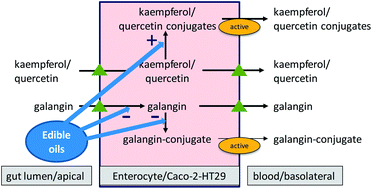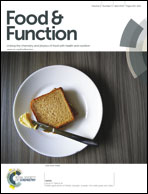Effect of edible oils on quercetin, kaempferol and galangin transport and conjugation in the intestinal Caco-2/HT29-MTX co-culture model
Abstract
Solubility and matrix play an important role in the gut lumen in delivering bioactive compounds to the absorptive surface of enterocytes. The purpose of this study was to determine the effect of certain commonly consumed lipids, soybean, olive and corn oil, on the transport and conjugation of flavonols (myricetin, quercetin, kaempferol and galangin) using the conjugation-competent co-cultured Caco-2/HT29-MTX intestinal cell monolayer model. To enable identification and quantification of conjugates, each flavonol was enzymatically glucuronidated or sulphated, then analysed by HPLC with triple quadrupole mass spectrometric detection. Quantification showed large differences in mass spectrometric peak area response factors between the aglycones and many of the conjugates, with galangin-sulphate for example ionising ∼15-fold better than galangin. Flavonol aglycones and conjugates were transported to the basolateral side of Caco-2/HT29-MTX co-cultures. The total amount of methyl, sulphate and glucuronide conjugates was in the order: galangin > quercetin > kaempferol > myricetin. All oils inhibited the transport and conjugation of galangin, the most hydrophobic flavonol, whereas they increased the sulphation, and to some extent glucuronidation, of quercetin and kaempferol. The results show that the lipid matrix has the potential to modify both transport and conjugation of dietary flavonols, but that the effect depends upon the structure and hydrophobicity.


 Please wait while we load your content...
Please wait while we load your content...